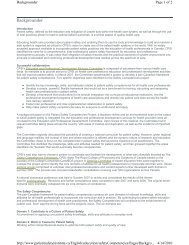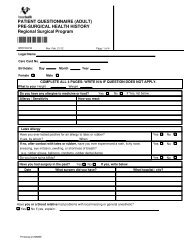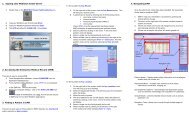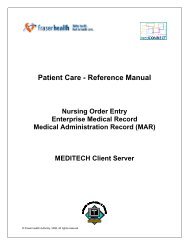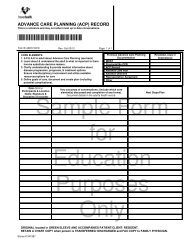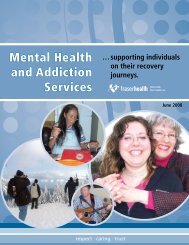Process - Physician - Fraser Health Authority
Process - Physician - Fraser Health Authority
Process - Physician - Fraser Health Authority
- No tags were found...
You also want an ePaper? Increase the reach of your titles
YUMPU automatically turns print PDFs into web optimized ePapers that Google loves.
Task Two: ADVISE1. Provide meaning and supportExplain a Model of SuicideProvide a model to help the patient understand theirsuicidality, and to normalize their feelings. People thinkseriously about suicide when they experience the 3 I’s intheir life situation: Intolerable (meaning their life situationis so painful that it seems unbearable), Interminable (itseems like it’s going to go on like this forever), andInescapable (it seems like nothing they’ve tried haschanged or will change their experience).Provide Coping StrategiesProvide strategies for coping that target the 3 I’s: Intolerable(distress reduction/tolerance strategies); Interminable(cognitive challenging techniques); and Inescapable(effective problem-solving). Provide Coping with SuicidalThoughts, a document to help individuals decreasethoughts of suicide, develop a safety plan and connect withhelpful resources.Reinforce the Value of TreatmentTreatment (both therapy and medication) can help to reduceyour suffering. Therapy can help you to identify and addressunderlying issues that are contributing to you feeling thisway, and provide you new ways of dealing with your lifeproblems. Medication can help you with difficulties you arehaving with [depressed mood, anxiety, sleep, appetite].Address Ambivalence in Order to Instill HopeMany people have mixed feelings about suicide, and are justlooking for some way to get out of the pain they are feeling.There are ways you can find support to help with that painthat don’t include ending your life.Reinforce Positive Coping Used in the PastWhat has helped in the past when you’ve had these thoughts?2. Develop a safety planDevelop an interim, written safety plan with the patient tohelp them stay safe until they secure longer-termprofessional supports. Provide written safety plan to patient,primary care provider and family/significant other(s).Discuss with the patient how to make their environmentsafe (remove risky means of self-harm; have friend or familyon-site for the short-term).Generate with the patient adaptive means of self-soothingand coping with distress (calling a friend, going for a walk).Generate with the patient reasons they have for living, andmethods they have used to cope in the past. Work withthe patient on completing the Safety Plan provided in thepatient handout, Coping with Suicidal Thoughts.Indicate to patient that if they try these steps and still do notfeel safe, they should go to a hospital emergency room orcall 911.3. Provide informationProvide a written copy of a treatment plan, including detailsof medications (if applicable) and dates of follow-upappointments to patient, primary care provider and family/significant other(s).If the patient is prescribed antidepressants, explain thatthere may be temporary increased risk as symptoms ofdepression resolve at different rates, and improvement ofmood may be delayed in comparison to improvement inphysical symptoms such as energy or sleep.Provide contact numbers of primary care providers (familyphysician, psychiatrist, psychologist), local crisis lines(1-800-SUICIDE) and mental health centres.Instill hope. Most importantly, let the patient and theirfamily/friends know that there is help available. Indicate thatalthough you cannot guarantee that there will be no furtherattempts or difficult feelings, prognosis will be much betterif the patient adheres to the treatment plan. Indicate that itmay take time to find the right diagnosis and treatment, andtime for patient to make accompanying changes.4. Follow-upFollow-up with the patient and/or family or significantother(s) within 48 hours to answer any questions they have,and to offer further information, including providingreferrals.Copies of this document, as well as the document Coping with Suicidal Thoughts, can be downloaded at no cost from the B.C. Ministryof <strong>Health</strong> (www.health.gov.bc.ca/mhd) or from the Centre for Applied Research in Mental <strong>Health</strong> and Addiction (www.carmha.ca).152




